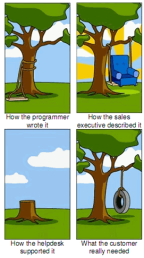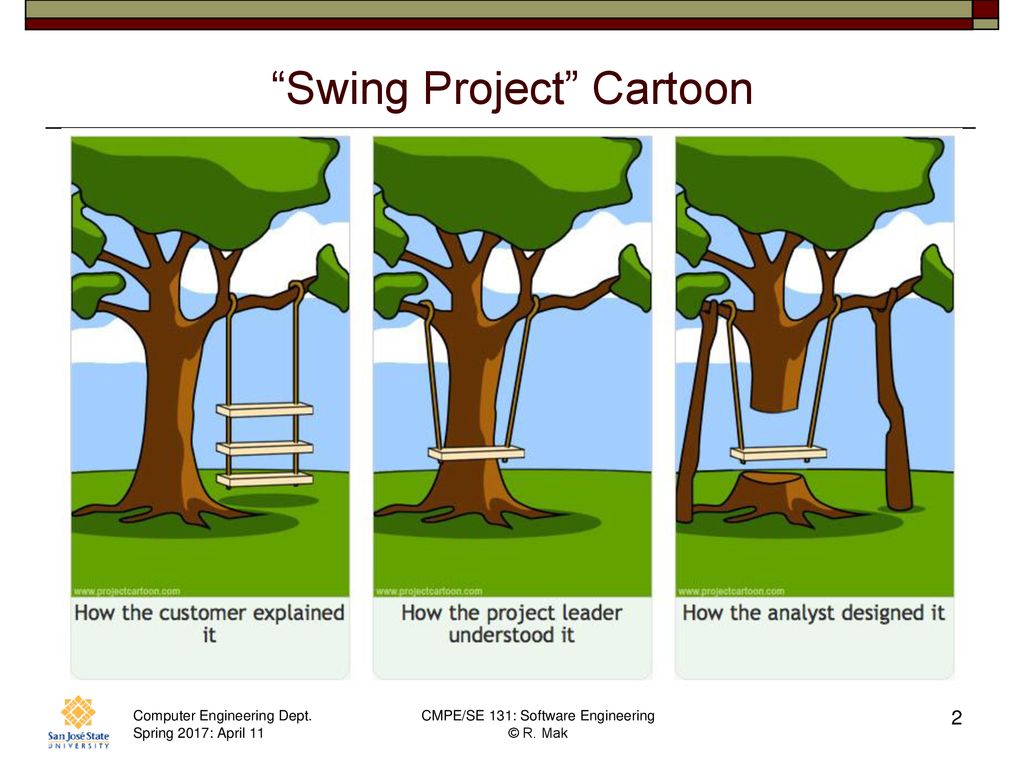- Cartoon Software Development Tree Swing Game
- Cartoon Software Development Tree Swing
- Cartoon Software Development Tree Swing Tutorial
- Cartoon Software Development Tree Swing Video
- Cartoon Software Development Tree Swing Design
A tree swing cartoon or tire swing cartoon is a humorous graphical metaphor that purports to explain communication pitfalls in the division of labor in the development of a product.[1][2] It depicts how different departments implement or describe a tire swing attached to a tree, and how different it is from what the customer actually intended. It has also been used to illustrate the waterfall model of software development.[3]

The original version appears to be from the early 1970s, possibly 1973.[4][5][6] Many variants of it appeared later in several books on education, software engineering and management.[7]
References[edit]
Dec 5, 2017 - The Tree Swing Cartoon Parodies, also known as “What The Customer Really Needed” (Japanese: 顧客が本当に必要だったもの), are a series of multi-pane, exploitable webcomics based on a satirical cartoon about building a tree swing through division of labor in corporate environment. Download for free Swing Cliparts #280865, download othes swing clipart for free.
- ^Eric Brechner (22 July 2011). I. M. Wright's 'Hard Code': A Decade of Hard-Won Lessons from Microsoft®. O'Reilly Media, Inc. pp. 127–. ISBN978-0-7356-6488-3. Retrieved 19 July 2013.CS1 maint: discouraged parameter (link)
- ^Ouellette & Associates Consulting, Inc (3 October 2008). Leading IT Transformation: The Roadmap for Success. Kendall Hunt Publishing Co. pp. 61–. ISBN978-0-7575-5833-7. Retrieved 19 July 2013.CS1 maint: discouraged parameter (link)
- ^Serengul Smith-Atakan (2006). Human-Computer Interaction. Cengage Learning EMEA. pp. 52–. ISBN978-1-84480-454-2. Retrieved 19 July 2013.CS1 maint: discouraged parameter (link)
- ^Cindy Dell Clark (16 May 2009). Transactions at Play. University Press of America. pp. 135–. ISBN978-0-7618-4486-0. Retrieved 19 July 2013.CS1 maint: discouraged parameter (link)
- ^'The Classic 'Tree Swing' Example of Production and Customer Service Gone Awry'. Encyclopædia Britannica Blog. Encyclopædia Britannica. Retrieved 19 July 2013.CS1 maint: discouraged parameter (link)
- ^'Origins of the tree swing pictures'. BusinessBalls.com. Archived from the original on 19 July 2013. Retrieved 15 October 2018.CS1 maint: discouraged parameter (link)
- ^'Origins of the tree swing pictures (new versions)'. BusinessBalls.com. Retrieved 19 July 2013.CS1 maint: discouraged parameter (link)
I was doomed to be an office worker because of my upbringing.
My father loves Dilbert. The family bookshelves are stuffed full with classics like Bring Me the Head of Willy the Mailboy, It’s Obvious You Won’t Survive By Your Wits Alone, and the management classic, The Dilbert Principle.
Over the past 26 years, Scott Adams has entertained millions of readers with his humorous workplace satire–and also poignantly highlighted some workplace problems that many easily glaze over.
One particular community that seems enamored of Dilbert is project managers. Many have been in offices where they have been micromanaged… or have become the pointy-haired boss themselves.
After scraping through thousands of Dilbert cartoons, I’ve found the best strips related to project management humor. Enjoy.
1.
Project managers with a PMP certification tend to outperform those who don’t have one. In order to pass the PMP exam, project managers must memorize project management vocabulary, understand project management processes, have experience in managing projects and, in some cases, must have taken project management courses.
With that said, PMPs can all too often get wrapped up in the minutiae of good processes–so much so that they hold them above the people they’re working with. No one wants to waste time in meetings, even if it’s vaguely recommended by other PMPs. Keep yourself grounded with real-time communication and simplified reporting that everyone can access and keep updated with instead of relying on meetings to do so.
2.
“Resource allocation” is a term familiar to many project managers, and it can often refer to people in addition to non-human assets.
Project management can often be a cold industry, where numbers and deadlines outweigh your team members’ desires and even capabilities. Keep in mind that your team members are people and that they each have their own unique needs and values.
3.
For many companies, risk management software adds safety to your project.
Unfortunately, even the best systems can’t function without the cognitive skills of a human working on the project (unfortunately, the successful Turing test has yet to come to risk software). If the data that you input does not match reality, your software will become useless.
4.
The Project Management Institute has continually found that poor communication is at the heart of most project failures.
There are many reasons for this, but the most common mistake that leads to poor communication is a poor system. Emailing every thought is unsustainable, but zero communication ultimately leads to project failure.
Investing in project management software is one of the best ways of addressing communication issues. In fact, 52% of project managers say that communication was “significantly improved” after implementing PM software. Consider using PM software instead of email–for instance, tools like Asana, Wrike, and Trello can help optimize communication.
5.
We have all met this project manager (or boss).
The know-it-all attitude is not only grating but also unhelpful. No team member wants to work for a “holier than thou” manager in any setting.
In this strip, Ratbert does not consider the skills of those he’s working with–he wants to dole out menial tasks while he does all the real thinking. Project managers cannot expect to come up with the best solutions to all problems all the time, and they can’t expect to have all their team’s individualized, specialized skills.

Make use of your team–distrusting your team to do any of the critical thinking will only end in disaster.
6.
Along the same lines as the previous cartoon, here Dilbert doesn’t trust his team not to sabotage his project. Unfortunately, that means he is not sharing the purpose or the scope of the project.

Can you spell d-i-s-a-s-t-e-r?
There is little that can be gained from keeping your team members in the dark. Transparency is the key to trust–and a team that trusts its leader will outperform those that don’t. Every time.
7.
Cartoon Software Development Tree Swing Game
As far as communication goes, I often hear project managers complain about their team members refusing to put in updates to their software, or having to chase down individuals for simple status updates.
On the other end of the spectrum, it’s also up to project managers to keep themselves informed. If checking status reports and staying up to date isn’t a part of your daily routine, you are opening up your project to unnecessary risk. Forecasts and requirements easily change. Don’t fall victim to your own inability to receive information.
8.
We’ve all heard stories about difficult team members. Some project managers get frustrated and chalk up inefficiencies with an unalterable personality trait. For example, the project manager here might think Wally is lazy, unavailable, and insubordinate.
In this case, that might very well be the reality. In the real world, however, there are many more variables. For example, the team member might think you’re unapproachable, unrealistic, and cold.
Invest in cultivating your workplace personality to best fit with project management, and try to get real-time feedback from your team members about your management style. Don’t wait for them to come to you.
9.
Cartoon Software Development Tree Swing
We’ve all experienced this problem. Unfortunately, dependencies are the greatest downfall to the Waterfall method of project management.
Going Agile, particularly for software products, is one way of addressing this issue, as is having realistic deadlines and properly matched tasks with skills.
Well, that and hiring competent employees, as is the issue in this strip.
10.
Cartoon Software Development Tree Swing Tutorial
Ah narcissism.
Listen when your team is trying to communicate with you. If you’ve built a reputation for poorly receiving information and status updates, you’ve set yourself up for poor team management.
No one wants to be the pointy-haired boss.
Cartoon Software Development Tree Swing Video
No one.
More?
There are literally thousands of Dilbert cartoons ripe for project management commentary. I’m sure I missed a ton. What is your favorite Dilbert strip? Anything to add to the ones I’ve included above?
Cartoon Software Development Tree Swing Design
Leave your favorites in the comments below!
Looking for Project Management software? Check out Capterra's list of the best Project Management software solutions.